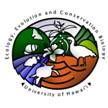Highlighted Activities
Cellular Sundae: Students will create models of plant and animal cells using a variety of sweet treats. Creating cellular models will give students a deeper understanding of cell structure. Students will learn the different parts of cells, and will learn the differences between plant and animal cells. Students will also learn to communicate scientific information.
Species Richness (Card Safari): Species richness is the number of different species in an area. Richness does not tell us anything about the relative abundance of these different species, but simply lets us know how many species are found in an area. This activity helps prepare students to make a general search, focusing sampling effort and standardizing techniques.
Where do snails go?: Black nerites (Nerita picea) are small (about 2-4 centimeter) snails that are abundant in the splash zone to the tide line. These littoral (dwelling in the intertidal zone) snails live on rocky shores, where they move in and out of the water, grazing on the algae on rocks. These snails often stay up where they are occasionally wet by the waves, and can tightly seal themselves to the rocks, preventing them from drying out. The snails are easy and safe to collect and handle and this experiment can be conducted on a field trip or in the classroom.
An Introduction to Sampling: Jellybeans in a Jar: Field ecology is a great way to introduce students to scientific methodology, as well as concepts like biodiversity, zonation, and invasion biology. It simply isn’t possible to examine or count every organism in an area. Sampling is a powerful tool that can allow us to categorize an area, without counting everything. It would be time-consuming, frustrating, and impossible to count every single snail on a beach or flower in the forest. Sampling is the process by which organisms in small areas can be counted, or quantified, to estimate abundance over a larger area. The small areas, or samples, must be representative of the larger area for these estimates to be accurate. The more samples we look at, the more accurately we will be able to describe an area. This is why replication, or repeatedly sampling an area, is important. Using representative sections of an area to estimate the composition of a larger site can be a challenging concept. This activity was developed to help introduce students to sampling and enable them to carry out studies of species diversity and abundance.
Seed Dispersal: Students will examine seeds and predict and test their means of dispersal. This lesson will help students learn about hypotheses and experiments, as well as understand the difference between observations and inferences, while learning about how plants colonized Hawaii and its offshore islets.
Explore more lessons here!


